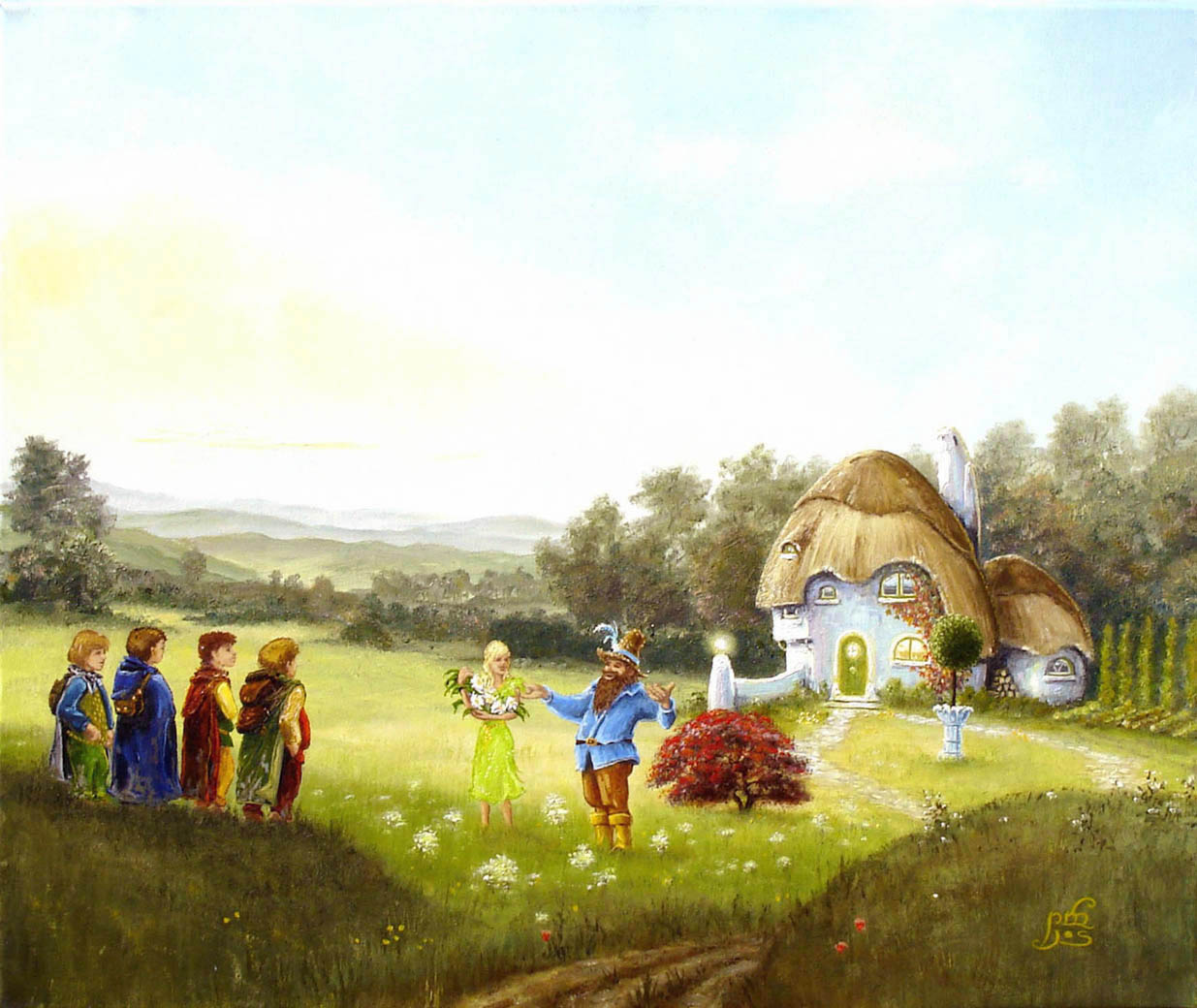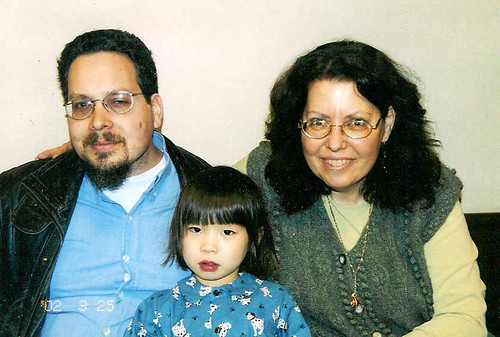|
|
Monday, April 6th, 2009
In this chapter there are two passages that strike me as very cinematic -- I can see them playing out animated on the screen. (Granted Tolkien was writing before the advent of anime, so he probably did not have that style in mind; but I think it is suited very well to his words.)
She lifted up her hand and from the ring she wore there issued a great light that illuminated her alone and left all else dark. She stood before Frodo seeming now tall beyond measurement, and beautiful beyond enduring, terrible and worshipful. Then she let her hand fall, and the light faded, and suddenly she laughed again, and lo! she was shrunken: a slender elf-woman, clad in simple white, whose gentle voice was soft and sad. This is just great. I can see her holding the ring up, it shining down on her, her transformation into something fearful -- it could be lifted right out of Howl's Moving Castle. Then there was a pause, and many swift scenes followed that Frodo in some way knew to be parts of a great history in which he had become involved. The mist cleared and he saw a sight which he had never seen before but knew at once: the sea. Darkness fell. The sea rose and raged in a great storm. Then he saw against the Sun, sinking blood-red into a wrack of clouds, the black outline of a tall ship with torn sails riding up out of the West. Then a wide river flowing through a populous city. Then a white fortress with seven towers. And then again a ship with black sails, but now it was morning again, and water rippled with the light, and a banner bearing the emblem of a white tree shown in the sun. A smoke as of a fire and a battle arose, and again the sun went down in a burning red that faded into a grey mist; and into the mist a grey ship passed away, twinkling with lights. It vanished, and Frodo sighed and prepared to draw away. I'm not as crazy about this. I think it could work really well on screen; but in the text something seems wrong with it. Those images are flashing by quickly, my gut reaction is that Frodo cannot be processing them as quickly as the narrator is telling us, and it makes it seem like a cheat. In the movie you would see all those images but you would not be able to narrate them in real-time like this -- you would have to assemble the narrative after the images had passed -- which is what I think Frodo would need to do, and by serving it up to us like this the narrator is taking us away from the story. Not sure this makes any sense, I'm trying to convey my impression here. Magic and prophesy are another element that LOTR has in common with Narnia and His Dark Materials -- maybe I did not mention this last time because it seemed obvious, magic and prophesy are sort of defining features of the fantasy genre -- but I think it would be worth a post at some point examining how magic and prophesy in the story, and the characters' response to them, affect my reading experience. I don't read very much fantasy, so I am noticing this part of the reading as something unusual.
posted evening of April 6th, 2009: 3 responses
➳ More posts about The Lord of the Rings
|  |
Tuesday, March 31st, 2009
As I've been reading His Dark Materials over the last few months, I've been trying to figure out how to tie it together with The Chronicles of Narnia. And now that I'm reading The Lord of the Rings, well... I can see some pretty distinct similarities to the other two series here as well. This post is for thinking about what parallels exist between the three series, and how they are different.
I think in each case, the author is working on three projects simultaneously. Primarily there is the story to be told -- in the case of LOTR and HDM the story is of a few central characters engaged in a quest; in Narnia it is much looser and less directed. But this is what's in front: you get to know and sympathize with some characters, take an interest in what's happening to them. The author's second task is the construction of a world (or in the case of HDM, a number of parallel worlds) to serve as the setting for the story. All three authors take this quite seriously, and all do it well -- though I am tempted to say Lewis' world-building is not on as high a level as Pullman's or Tolkien's, getting involved in the fictional universe is a core part of the experience of reading any of these series. One key difference is that Lewis and Tolkien rely on folklore and myth to build their worlds, where Pullman is trying to express the world (primarily) of Christian myth without relying on superstition. Pullman's is a hugely more ambitions project here, and this bit of it is not always successful. (The portion of HDM that in retrospect I found the most affecting, the descent into the world of the dead, was also the portion where the least attention was paid to science and the most use made of mythology.)
Undergirding all this is an ideological project, what I'm thinking of as an ontological narrative. Lewis is interested in retelling the story of Christian theology -- I have not studied the books closely enough to be more specific than that, there is a lot of writing on the subject out there though. Pullman (whose work can be seen as an answer to Lewis) is interested in creating a world without God, reframing the story of Christian theology into a grasping for power by forces of ignorance. (He does a magnificent job of it, though I was mainly taken with the primary story in HDM, the story of Lyra and Will's quest.) I haven't read enough of Tolkien yet to understand what his ontological narrative is; and it may be that in LOTR the main thing is really the world-building project.
posted evening of March 31st, 2009: Respond
➳ More posts about J.R.R. Tolkien
|  |
Monday, March 30th, 2009
Two things about The Hobbit, which I started reading aloud with Sylvia last night: It is a whole lot of fun to read aloud, with opportunities for doing new voices at every turn; and it seems like it will be kind of fun to be reading in parallel with The Fellowship of the Ring. I'm just at the point in Fellowship, where the party is leaving Rivendell; in a lot of ways this seems like the real beginning of the story, with the first half of the book having been a prologue. I'm interested in Frodo, Sam, and Strider; none of the other travellers has really got my attention yet. (Besides Gandalf of course; but he distinctly does not strike me as a real character, as a human.) Pippin and Merry both have had moments but they are generally in the background so far.
posted evening of March 30th, 2009: 4 responses
➳ More posts about The Hobbit
|  |
Saturday, March 28th, 2009
I stayed up late last night reading The Fellowship of the Ring; it is starting to really come together for me. In the first several chapters I was feeling a little annoyed at the pace -- granted this is a three-volume, 1500-page story that is being set up, so it is only reasonable that Tolkien spend some time setting it up... Around Chapter VII ("In the House of Tom  Bombadil") is where the story really begins to pick up and feel interesting to me. For one thing I just love the characters Tom and his wife Goldberry -- "characters" might not be the right word here, they are just quick sketches meant to move the story along; but they are lovingly drawn and engaging. Bombadil") is where the story really begins to pick up and feel interesting to me. For one thing I just love the characters Tom and his wife Goldberry -- "characters" might not be the right word here, they are just quick sketches meant to move the story along; but they are lovingly drawn and engaging. I see a potential criticism of this book, of the early part at least, that Frodo and his friends are just moving along from one deus ex machina to the next. Compare Frodo and company getting lost in the Barrow Downs, with Bilbo and the dwarfs getting lost in Mirkwood. The two sequences are built up similarly: the characters follow illusions into the wilderness and are separated and black out, then the main character awakens and finds his companions hostage. In The Hobbit, Bilbo rescued the dwarfs by calling on an inner reserve of strength which we did not know he had, fighting off the spiders with his dagger; in Fellowship, Frodo rescues his companions by invoking the song of Tom Bombadil -- Tom comes and destroys the barrow-wight without breaking a sweat. This avoids being lame by virtue of Tom being such a fun presence -- I was happy enough to see him back in the story for a bit longer, I didn't bother about the ease with which they busted out. And of course this is taking place much earlier in the story, than the Mirkwood episode in The Hobbit.
posted morning of March 28th, 2009: 2 responses
➳ More posts about Readings
| |
|
Drop me a line! or, sign my Guestbook.
•
Check out Ellen's writing at Patch.com.
| |









 Uncle Eddie
Uncle Eddie 